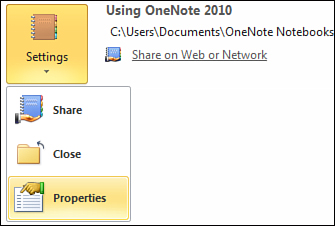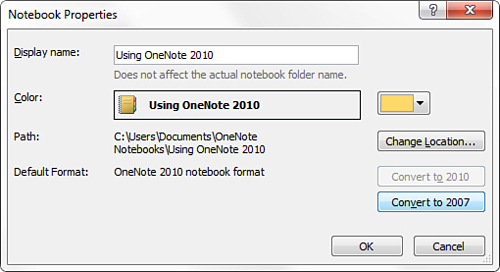Upgrading from OneNote 2003
OneNote 2003 was the
first-ever released version of OneNote. Although it was a noteworthy and
capable debut in its time, it is now mostly incompatible with the
majority of the features that have been introduced in both OneNote 2007
and OneNote 2010.
If you’re upgrading to
OneNote 2010 from OneNote 2003, you are prompted to update all of the
files in your My Notebook folder (OneNote 2003 supported only a single
notebook), so that you can use all of the features in OneNote 2010 with
your old notes. This is highly recommended.
However, after your old
notebook files have been updated, OneNote 2003 will no longer be able to
read them. This is because the older program can’t possibly understand a
file format that was invented some seven years later. Before you choose
to let OneNote 2010 update your old notes, first consider whether you
will ever need to use them in the older OneNote 2003 program again (for
example, if you have a second copy of OneNote 2003 on another computer
that you won’t be upgrading). If so, be sure to first create a complete
backup of all of your old notebook files.
If
you decline to update your OneNote 2003 notebook files as part of the
OneNote 2010 upgrade, you can only view them in OneNote 2010 as
read-only files, but you cannot edit them.
Upgrading from OneNote 2007
OneNote 2007 has several key
features in common with the newer OneNote 2010 (among them, support for
multiple notebooks and shared notebooks). Although OneNote 2007
naturally cannot read files in the newer OneNote 2010 format, OneNote
2010 fully supports opening, viewing, editing, and sharing notes in the
older OneNote 2007 format. This means you can choose whether you want to
keep using your existing notebook files in the older OneNote 2007
format, or whether you want to update them to the newer, more capable
OneNote 2010 format.
If you choose to leave your
notebook files in the older OneNote 2007 format, you will not be able to
use the following OneNote 2010 features in your notebooks:
Linked Notes
Notebook Versioning
Notebook Recycle Bin
Multilevel Subpages
Math Equations
To enable all of these
features in OneNote 2010, updating your files to the newer format is
required. Thankfully, however, you can change formats at any time, if
needed, by using the built-in conversion utility in OneNote 2010. This
utility lets you convert any notebook from the OneNote 2010 file format
to the OneNote 2007 file format—and back again.
The ability to switch
formats at will was included to maximize compatibility for shared
notebooks in environments in which both OneNote 2007 and OneNote 2010
are in use at the same time. If you upgraded your older notes to the new
OneNote 2010 file format and then realize you need to share those notes
with people who are still using OneNote 2007, you can downgrade the
files and then share the notebook among users of both versions.
The main caveat to
downgrading your notes from the OneNote 2010 format to the older OneNote
2007 format is that your notes will lose or ignore the aforementioned
newer features that only OneNote 2010 can understand, which means that
you will also lose the information they created or provide. For example,
if you used the Linked Notes feature and then downgrade those notes to
the older OneNote 2007
format, the functionality is unavailable unless you update the file
format again. However, simply upgrading to the new format once again
will not automatically restore any information that was lost.
Converting a Notebook to the OneNote 2007 Format
Use the blank, to see how easy it is to change the notebook file to the older OneNote 2007 file format.
1. | Near
the top-left corner of the OneNote program window, click the File tab.
This opens the Backstage View, where you can manage your notebook files.
|
2. | Under
Notebook Information, find the practice notebook you created (“Using
OneNote 2010”) and then click the Settings button for that notebook.
|
3. | On the menu that appears, click Properties (see Figure 1).

The Notebook Properties dialog box opens (see Figure 2).
Here, you can rename the currently selected notebook, change the color
of its icon, change its location, and convert its file format.

If the current notebook is in OneNote 2010 format (which the Using
OneNote 2010 notebook is), only the Convert to 2007 button is available.
Similarly, if the notebook were in the older OneNote 2007 format, only
the Convert to 2010 button would be available.
|
4. | Click the Convert to 2007 button.
|
5. | When the warning about the affected OneNote 2010 features appears, click OK to acknowledge the message.
|
When the dialog box closes, the notebook is converted to the older OneNote 2007 format.
You can verify that you’re
using a notebook in the OneNote 2007 format by looking at the title bar
in the top center of the OneNote 2010 program window. If the words
“Compatibility Mode” appear after the page title (see Figure 3), it means you’re working in the older format.

Converting a Notebook to the OneNote 2010 Format
Now convert your practice
notebook back to its original (newer) format so you can use all of the
features in OneNote 2010 during the upcoming practice sessions.
The steps are nearly the same as before:
1. | Select the File tab.
|
2. | Under Notebook Information, click the Settings button next to the Using OneNote 2010 notebook.
|
3. | On the menu that appears, click Properties.
|
4. | In the Notebook Properties dialog box, click the Convert to 2010 button.
|
5. | When the warning about sharing the notebook with OneNote 2007 users appears, click OK to acknowledge the message.
|
When the dialog box closes, the
notebook is converted to the newer OneNote 2010 format and the
“Compatibility Mode” warning on the OneNote title bar will disappear.
Additional File Conversion Considerations
If you open a notebook that
contains individual sections which are stored in the older OneNote 2007
format, an Information Bar appears at the top of every page in that
section to warn you of the possible incompatibility. Click the
Information Bar to convert that particular section (or the entire
notebook the section is stored in) to the newer OneNote 2010 format.
If you should attempt to
move any page or section from a notebook in one format to a different
notebook in another format, OneNote 2010 will display a warning before
attempting to convert your notes.
As with all
important computer files, it’s a good idea to create a complete set of
backups that you’ll store on a different hard drive for safekeeping
before you experiment with notebook conversions (especially if you’re
upgrading from OneNote 2003).